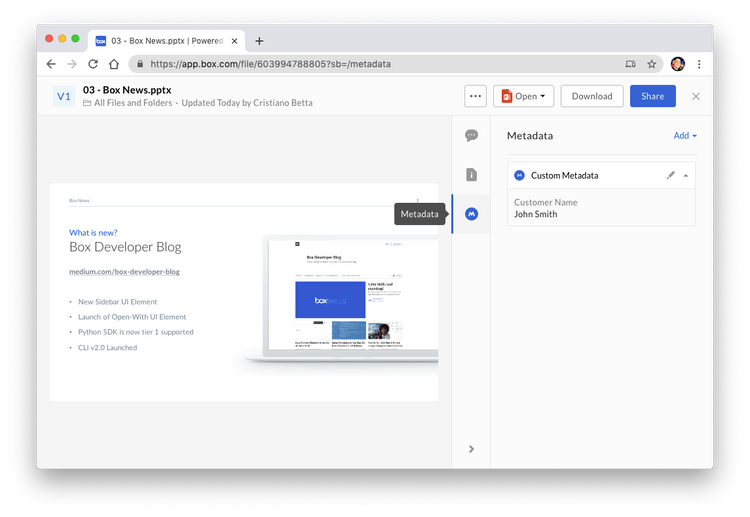Metadata
Metadata
Metadata allows users and applications to define and store custom data associated with files and folders.
Metadata consists of key/value pairs that are assigned to a file or a folder.
For example, an important contract may have the key/value pairs of
clientNumber: 820183 and clientName: bioMedicalCorp.
Metadata terminology
Working with metadata requires a developer to work with a few distinct types of resources.
- Templates: A metadata template describes a re-usable set of key/value pairs that can be assigned to a file. For example, an
invoiceDatatemplate might hold data about an invoice, having a field for the invoice ID as well as the customer ID. - Fields: A metadata template field describes a specific piece of data within a metadata template. For example, the ID of an invoice might be represented as an
idfield on aninvoiceDatatemplate. - Instances: A metadata instance describes the relation between a template and a file or folder, including the values that are assigned for every field. For example, a user might have assigned an
invoiceDatametadata template to a file and provided 2 values, one for the invoice ID and one for the customer ID. You can assign up to 100 templates to specific file or folder. - Cascade Policies: A metadata cascade policy describes how metadata instances applied to a folder should be applied to any item within that folder. For example, a user might assign the same
invoiceDatametadata template to a project folder (including the 2 values), allowing them to automatically apply to all the files and folders within that project folder. - Queries: A metadata query provides a way to find files and folders by searching for the metadata attached to them. For example, to find all the files for an invoice with a certain ID, the query would look for all files and folders with the
invoiceDatatemplate attached to it and a value ofid = :id, where:idwould be the value of the invoice.
The purpose of metadata
Metadata can be used for many purposes. Enterprises may want to have a better way to organize their digital assets for their marketing teams, or developers may want to provide advanced content functionality such as facilitating workflows or approvals.
For example, a marketingCollateral template may define where and when specific
marketing content should be used. Users can see a representation of the
template in the Box web application while navigating to a file preview.
To learn more, please visit Box community articles.
